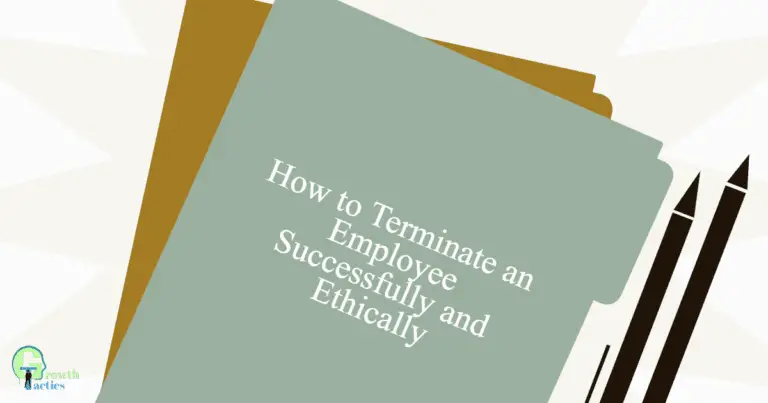Terminating an employee is never an easy task. It is a process that should be approached with caution, empathy, and professionalism. When done correctly, it can lead to a seamless transition for both the employee being terminated and the company as a whole. In this article, we will discuss the steps involved in terminating an employee successfully and ethically, as well as provide some tips to help you navigate this challenging process.
Jump To Section
Steps for Terminating an Employee
If applicable, give the employee an opportunity to improve first
Before jumping straight to termination, it is essential to give the employee a chance to improve their performance or behavior. This can be done through a performance improvement plan or by providing clear feedback and expectations. By giving the employee an opportunity to grow, you demonstrate your commitment to their success and provide them with a fair chance to turn things around.
Consult your HR and Legal teams
Prior to terminating an employee, it is crucial to consult with your HR and Legal teams to ensure that you are following all applicable laws and company policies. They can provide guidance on the appropriate course of action, offer insight into any potential legal implications, and help you navigate the termination process smoothly.
Prepare for the termination meeting
Once you have made the decision to terminate an employee, it is important to prepare for the termination meeting. This includes gathering all necessary documents and information, such as the employee’s performance evaluations, any disciplinary records, and details about their termination benefits, if applicable. Having this information readily available will help you conduct the meeting effectively and address any questions or concerns the employee may have.
Conduct the meeting — and listen to the employee
When it comes time to terminate the employee, it is crucial to conduct the meeting with professionalism and empathy. Start by explaining the reason for the termination clearly and concisely. It is important to be honest and direct while also remaining respectful and compassionate. Allow the employee to express their thoughts and feelings and be prepared to listen actively. While you may not be able to change the outcome, showing empathy and understanding can help soften the impact of the news.
Gather any company property
During the termination meeting, be sure to collect any company property that the employee may have in their possession, such as keys, access cards, laptops, or mobile phones. This helps to ensure a smooth transition and avoids any potential misuse of company resources. Make sure to document the return of such items and provide the employee with a receipt to confirm the handover.
What Not to Say When Terminating an Employee
When terminating an employee, it is important to choose your words carefully. What you say (and how you say it) can have a significant impact on the employee’s emotional well-being and future professional prospects. Here are a few things to avoid when delivering the news:
1. Don’t offer false hope or promises
It is essential to be honest and upfront with the employee. Offering false hope or making promises that cannot be kept will only lead to further disappointment and resentment.
2. Don’t blame the employee
Avoid pointing fingers or assigning blame during the termination meeting. Instead, focus on the specific performance issues or misconduct that led to the decision.
3. Don’t disclose confidential information
Respect the employee’s privacy and avoid disclosing any confidential or sensitive information during the termination meeting. Stick to discussing the reasons for the termination and any relevant details pertaining to the employee’s transition.
4. Don’t engage in arguments or debates
While it’s important to listen to the employee and be empathetic, avoid getting drawn into arguments or debates about the termination decision. It is unlikely to change the outcome and may only escalate tensions.
Reasons for Termination
There are various reasons why an employee may need to be terminated. These can range from performance-related issues to serious misconduct or violations of company policies. Here are some common reasons for termination:
Discrimination
Terminating an employee due to their race, gender, age, or any other protected characteristic is illegal and can result in severe consequences. Employers must ensure that all termination decisions are based on legitimate business reasons and not on discriminatory factors.
Poor employee performance
Employees who consistently underperform, despite ample opportunities for improvement, may be subject to termination. However, it is important to document performance issues, provide appropriate feedback and support, and give the employee a fair chance to demonstrate improvement before taking such action.
Unethical behavior
Employees who engage in unethical behavior, such as theft, fraud, or harassment, may be subject to termination. Organizations have a responsibility to maintain a safe and respectful work environment, and terminating employees involved in unethical conduct is a necessary step in achieving this goal.
Harassment or other illegal activity
Any form of harassment, including sexual harassment, should not be tolerated in the workplace. Employers have a legal and ethical obligation to investigate and address any claims of harassment promptly. Termination may be necessary if an employee is found guilty of such conduct.
Downsizing
In some cases, termination may be necessary due to economic factors, such as downsizing, restructuring, or financial constraints. However, it is important to follow legal requirements and ensure fairness when selecting employees for termination during downsizing.
The Human Element of Termination
Terminating an employee is not just a legal or administrative process; it also has a significant impact on the individuals involved. Both the employee being terminated and the remaining employees may experience various emotions, including fear, uncertainty, and sadness. As a manager or employer, it is important to acknowledge and address these emotions to maintain morale and a positive work environment.
Communication is key during this transition period. Keep the lines of communication open and be transparent with the remaining employees about the reasons for the termination and how it will impact the organization. Address any concerns they may have and provide reassurance where possible.
Do Your Research
Exceptions to At-Will Termination
It is crucial to understand the exceptions to at-will termination, as the laws regarding termination can vary depending on the jurisdiction and employment agreements. Certain employees may have contractual rights that protect them from being terminated without cause. Familiarize yourself with the applicable laws and consult with your legal team if you have any doubts or questions.
Federal Termination Laws
In addition to the exceptions to at-will termination, there are federal laws that protect employees from being terminated for specific reasons, such as discrimination based on race, gender, religion, or disability. Familiarize yourself with these laws to ensure compliance and avoid potential legal consequences.
Illegal reasons to fire an employee
Be aware of the illegal reasons to fire an employee, such as discrimination, retaliation, or whistleblowing. Terminating an employee based on any of these reasons can result in legal consequences and damage to the organization’s reputation.
Additional Tips for Terminating Employees
In addition to the steps outlined above, here are some additional tips to help you navigate the termination process successfully:
Offering Continuous Feedback Before Firing Someone
Providing continuous feedback to an employee before resorting to termination is not only crucial but also exemplifies a responsible approach to managing human resources. When an employee is struggling or failing to meet expectations, it is essential to address the issues promptly and openly through ongoing feedback. Regular feedback sessions provide an opportunity to discuss areas for improvement, set achievable goals, and offer support and guidance.
Have HR as a witness
It is always a good practice to have a representative from the HR department present during the termination meeting. This provides an unbiased witness, ensures compliance with company policies and procedures, and offers support and guidance during the process.
Establish Your Own Termination Standards
Consider establishing your own termination standards or policies that align with your organization’s values and culture. Clear guidelines can help ensure consistency and fairness when terminating employees. 1. Communicate clear expectations: Clearly outline the performance standards and behaviors expected from employees at the time of onboarding. This includes providing a detailed job description, performance metrics, and guidelines for behavior and conduct.
Document Early and Often
Document performance issues, disciplinary actions, and any other relevant information throughout the employment relationship. This documentation can be crucial in supporting termination decisions and defending against potential claims of wrongful termination.
Break the News In Person
Whenever possible, deliver the news of termination in person. This shows respect for the employee and allows for a more personal and empathetic conversation. Avoid terminating employees via email or other impersonal methods unless absolutely necessary.
Plan Ahead
Prior to terminating an employee, consider the logistical aspects such as finalizing their last paycheck, benefits, unused vacation days, and any applicable severance packages. Planning ahead can help ensure a smooth and efficient transition.
Keep It Simple
When discussing the reasons for termination, keep the conversation direct and to the point. Avoid providing unnecessary details or engaging in lengthy explanations. Stick to the facts while being respectful and empathetic.
Conclusion
Terminating an employee is a challenging and delicate process that requires careful consideration, empathy, and well-defined procedures. By following the recommended steps, avoiding common pitfalls, and prioritizing the well-being of all parties involved, employers can successfully navigate the termination process while maintaining their integrity and fostering a positive work environment.


